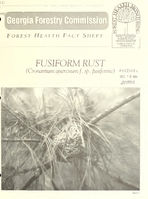LU&1U LL
Forest Health Fact Sheet
FOREST PEST
MANAGEMENT
GEORGIA FORESTRY COMMISSION
FUSIFORM RUST
(Cronartium quercuumf. sp. fusiforme)
RECEIVEb
2 DEC. 1 1994
UUCUMENTS
.
Figure 1
Fusiform rust, is the most
damaging disease of slash
and loblolly pines
throughout the southeastern
United States. This disease
causes stem, branch and tmnk cankers (galls) to fonn on
infected trees (Figures 1 and
2). The majority of infections
occur prior to age 5. In the
early spring active galls pro-
duce yellow-orange spores
(aeciospores) that are
windblown to young, tender
oak leaves. Water, willow and
laurel oaks are the most
susceptible species affected.
The fungus goes through three
additional spore stages
underneath the oak leaves.
(Figure 3) The fourth and final
stage results in basidiospores
being formed. The
basidiospores are windblown to new pine needles and/or succu-
Figure
lent green bark areas of young trees
thus completing the disease life
cycle.
The amount of infection in
planted and natural pine stands
varies considerably across the
South. Factors such as individual
tree resistance, site characteristics
and rust virulence all interact to
influence infection levels.
When regenerating sites to pine,
land managers must take steps to deal with fusiform rust. Below are
some practices that will help
minimize rust problems and protect economic investments.
These seedlings are the result of
many years o( valuable research
that hopefully will result in increased seedling resistance to the disease. Further protection from rust is provided by timed applications of fungicides to these
seedlings at the nursery. However, sometimes these fungicides do not get applied for one reason or another. Occasionally seedlings will
leave the nursery that are rust infected. Seedlings should be inspected for obvious stem swellings
and culled prior to planting (Figure 4). Infected seedlings should be
reported to the appropriate nursery
ARTIFICIAL
REGENERATION
officials immediately. Don't wait. In high hazard regions increase
planting densities to allow for
Use nist resistant seedlings (improved) that are available from state and privately owned nurseries.
anticipated losses. This will, o(
course, increase the number of
thinnings required throughout the
life of the stand. Consider site preparation
techniques that reduce oak trees unless they conflict with (
other management objectives
(prescribed burning, herbi-
cides, and intensive mechani-
cal preparation).
Use seed from a resistant source. Seed should be treated with an approved bird and
rodent repellent (see appen-
dix).
NATURAL
REGENERATION
If the seed tree or shelter-
wood method is used, select
disease-free seed trees.
TM MANAGING ESTABLISHED j STANDS Evaluate plantations at age 3-5
to ascertain the amount of rust
infection. Plantations that are
showing 50% or more infections
should be seriously considered for
clearcutting. If the decision is made
not to clearcut, a sanitation cut should be planned as soon as it is economical.
After age 5 it is usually
uneconomical to clearcut and start over. However, rotation ages will need to be adjusted in order to maximize on the establishment costs.
In older stands with less than 50% stem infections, remove as many
stem cankered trees as possible with each thinning. Try to maintain a basal area of 75-85 sq. ft. per acre or t at least 200 trees per acre.
When thinning plantations, be
sure to consider annosus root rot.
I
II
3 ElDfl DMMM^ ETIT
e
to
4--
cL
c/)
E
=3
(J ^_ CD
cr
< (0
E
=3
Ooc
o
OLl.
UJ <
Oi O>- |
5
C/3
UJ Ll
C/3
at
III lll
IT
jj o Q. I
go (/) J 1%
Id Z j
h "111
h
.
;r~^K
YARD TREES
Photo, Dr. Harry Powers, retired USFS
Figure 4
Severely cankered trees often break at the canker during storms with 35 mph. winds or above. Although its hard
to predict breakage, trees closest to homes, powerlines etc. should be removed. Otherwise trees with cankers that do
not girdle more than 1/2 the stem's circumference usually pose no immediate threat
However, wind direction and tree location is critical, when predicting hazard.
